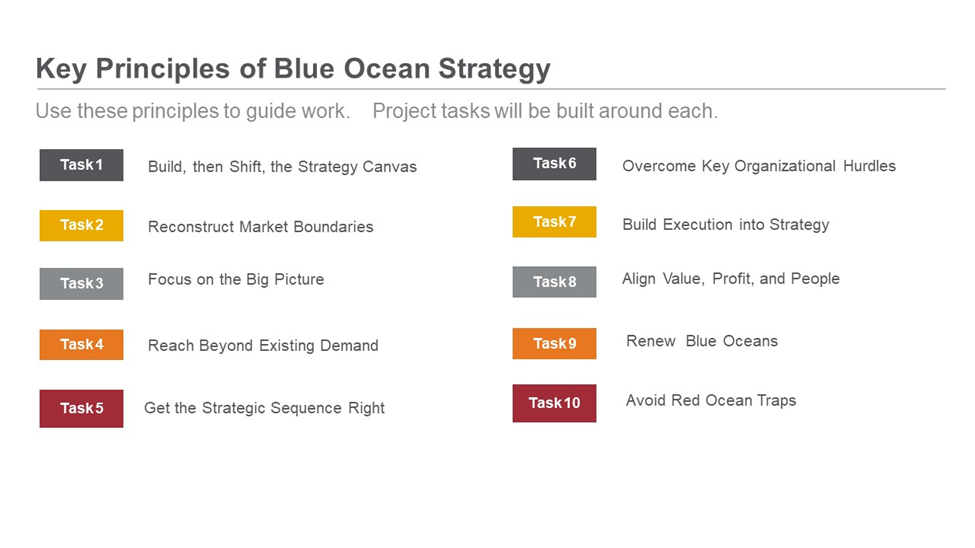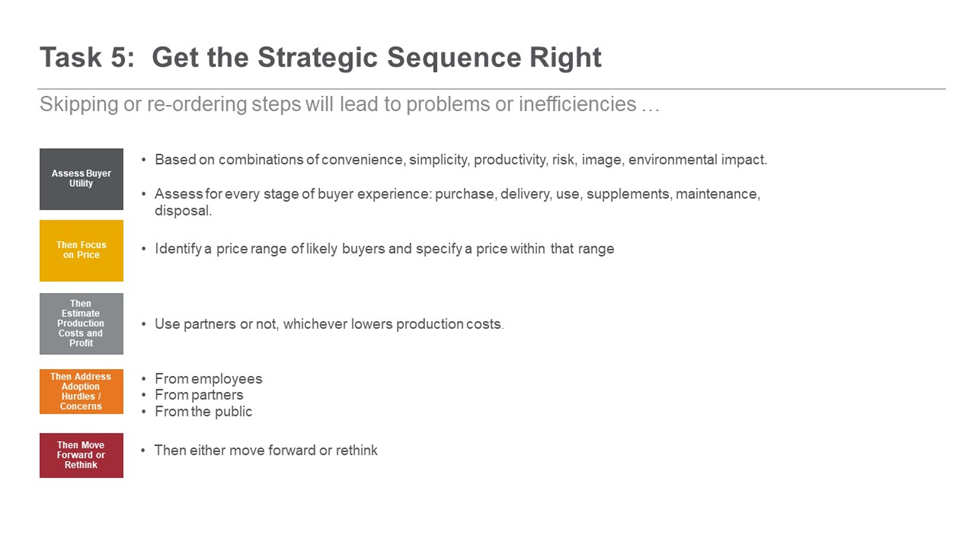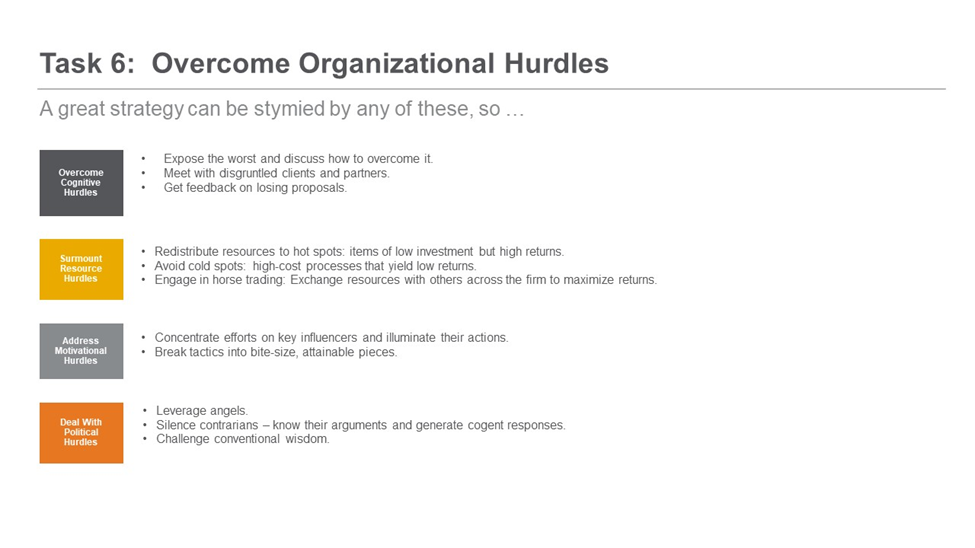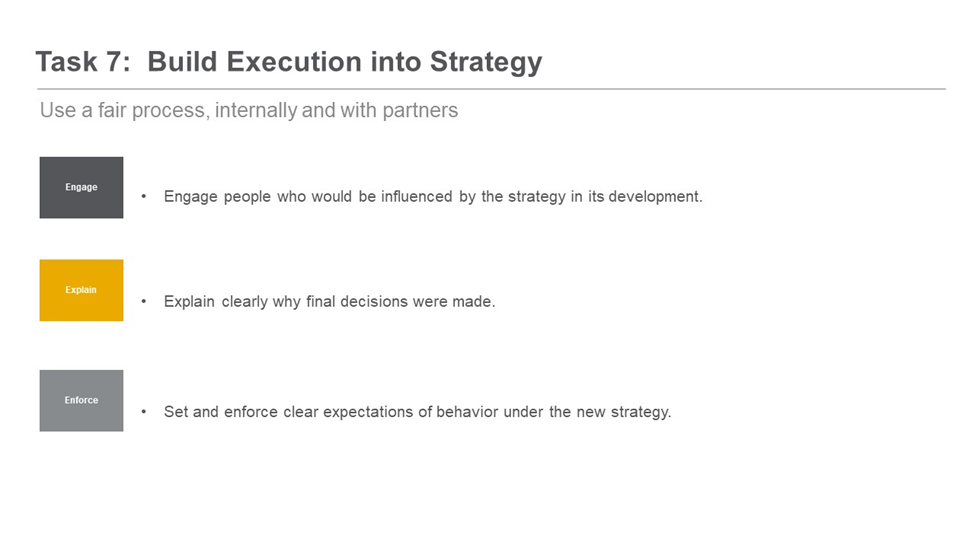https://ift.tt/92ZmxKr Managing the Process Photo by Christina Wocin on unsplash.com (This paper was published previously in Open Data ...
Managing the Process

(This paper was published previously in Open Data Science, on January 31, 2022, on https://opendatascience.com/using-data-science-to-develop-a-winning-business-strategy-part-3/.)
What role should data science teams have when creating a great business strategy that makes competitors irrelevant? The answer lies in an application of Blue Ocean Strategy, a set of concepts developed by W. Chan Kim and Reneé Mauborgne (2015) in their famous book by that name.
The Kim and Mauborgne (K&M) text is not related specifically to data science. In this three-part series I add a data science perspective to their concepts. I describe how data scientists can work with others across every organizational unit to develop a profitable business strategy, get more clients and enhance their satisfaction — without interference from existing competitors.
In the first article of this series, we began to examine the role data scientists can play when creating a great business strategy that makes competitors irrelevant. The initial phase of that role involves creating a strategy canvas, using concepts developed by K&M. Getting the strategy canvas right is a key factor in its success; getting it wrong can lead to wasted time and money.
In Part 2 of the series, I described how data scientists can use the strategy canvas and other tools to create new demand for their offerings. Here in Part 3, after a brief recap, I focus on how to manage efficiencies in blue ocean strategy and on gaining support for it by aligning incentives in its favor. Since strategy is long-term in nature, I also describe how data scientists can help renew blue oceans and avoid traps that might subvert it. Finally, I note its limitations and offer conclusions about how data scientists can contribute to blue ocean success.
Recap — What is The Blue Ocean, and What Role do Data Scientists Play in it?
According to K&M, and as mentioned earlier in Part 1, the blue ocean is where potential clients work but your competitors do not (not yet anyway). Quoting from their text (page 18), the blue ocean is where you can:
· Create uncontested market space
· Make the competition irrelevant
· Create and capture new demand
· Break the value-cost trade-off
· Align the whole system of a firm’s activities in pursuit of differentiation and low cost.
The blue ocean is business nirvana — there are no competitors to whittle away profits yet and it is easier to make a reputation for innovation in it. Getting there is not easy, but data science can help.
Briefly, the role of data science in blue ocean strategy is to provide insights needed by team members across the business, to help them find blue oceans and thrive there. Those insights arise from the following ten principles K&M describe, and we describe how data scientists can contribute to each one.

Maximizing Efficiencies in Blue Ocean Strategy
The first four tasks of the blue ocean strategy process were covered in Parts 1 and 2 of this series. We pick up here with Task 5, which is to make sure efficiencies are maximized in the process. The next figure describes the steps involved in this task.

According to K&M, the first step of this task is to assess buyer utility, which is a function of consumer convenience, productivity, image, risk, or environmental impact. If these are what potential clients value, then data scientists should focus modeling efforts on these things, if possible. One way my colleagues and I have done that is via pre-sales analytics.
Pre-sales analytics are just what the term implies: a set of analytic models generated by data scientists who predict the type and magnitude of benefits or value that clients would obtain by purchasing your offerings. Rigorously conducted pre-sales analytics yield client confidence in their investments in your offerings.
In one health and wellness management firm where I worked, pre-sales analytics focused on predicted probabilities of hospital admission and then readmission within 30 days after discharge, and on client cost savings associated with buying our health and wellness programs. These pre-sales analytics involved classification and/or regression models designed to forecast for clients whether the money they would save from these programs would more than offset the prices we would charge them. Pre-sales analytics vary by type of program or by patient demographics and health characteristics. Our work here was more red ocean than blue, since we were competing for clients with other program vendors. Expanding into a blue ocean would require a focus on creating value for clients outside our industry who also wanted to improve the health and wellness of consumers not normally covered by our programs.
One potential for blue-ocean work in this sphere lies in the ability to create value for individual consumers who are not affiliated with typical clients. In our health and wellness management example, this would mean building offerings for people to buy online, without requiring them to have any affiliation to a particular employer or health insurance plan that typically bought our programs. In business parlance this would be a D-to-C (Direct to Consumer) approach, rather than an indirect B-to-B-to-C (Business to Business to Consumer) approach.
We found the D-to-C nut hard to crack for two reasons. First, participation in our programs was free to individual patients or workers because their employers or insurance companies were footing the bill. Direct-to-consumer applications or programs are not free — someone must pay, so prices should be low and perceived value must be high enough to justify payment out of one’s own pocket. Second, the technology required to produce high-value programs was nascent. It is evolving now, with the onset of consumer devices to monitor blood sugar, heart rate, and other health indicators, but it may take a few more years before such technology is ready for prime-time or approved by regulatory bodies. Regardless of product or industry, the general challenge for data scientists is to create models or other offering features that accurately forecast value, and to conduct simulations designed to illustrate the value of prototypes to potential buyers outside their usual markets.
Other aspects of the strategic sequence are also noted in the Task 5 figure above. K&M note that perspectives of colleagues and the public are important to consider and use. This applies to predictive modeling efforts conducted by data scientists as well.
The perspectives, capabilities, and costs of using partners to help develop new offerings are also important, as they note. If your potential partners share your vision, have capabilities that complement your own (without competing with yours), and if they agree to work with you for a reasonable price, it might make sense to collaborate with them instead of doing all the blue-ocean development work yourselves. If the development work can be done in a way that allows an attractive price to be offered to potential end-users or other buyers, and if that pricing strategy would produce substantial profits for your firm, then continue. Otherwise stop and rethink the blue-ocean development project.
Overcome Organizational Hurdles
The next task in the blue ocean strategy process is to overcome internal organizational hurdles. Four related hurdles were identified by K&M and are noted in the Task 6 figure below. Effective communication between supporters and non-supporters across the organization, and with clients and potential clients, is needed to surmount these hurdles and keep the strategy alive so you can find blue oceans. Such communication requires efforts to understand where each stakeholder is coming from, so informed conversations become productive. Effective communication also requires transparency in methods and findings, which in turn require interpretable, explainable, and fair models. Hall and Gill (2019) describe how to produce such models; this should be required reading for every data scientist.

Combine Strategy with Execution, then Align Value, Profit and People
Next, as the Task 7 figure below implies, strategy must beget execution so progress toward blue oceans can be made. K&M say that successful execution of the strategy is more likely if all relevant stakeholders within and outside the firm are represented or engaged in its development. Their participation will increase the likelihood they understand, and support, decisions made. K&M also say clear expectations among stakeholders must be set in advance and reiterated and discussed throughout the process. Fair enforcement of, or appropriate changes to, those expectations must be applied when needed.

According to K&M, moving strategy into execution will be easier if the precepts noted in the Task 8 figure below also are applied. Adhering to these precepts requires data science to be grounded in the models, features, or other attributes that produce utility for clients. Their work also must be conducted in a representative, accountable, and efficient manner. Getting back to the CRISP-DM and Updated Data Science Lifecycle mentioned in Part 2, the focus on utility will be much more productive if significant efforts are spent to understand the business needs of clients before modeling. My earlier paper stresses the importance of this activity, and a new paper by Cornelius Yudha Wijaya (2021) shows how to do it.

One more point about execution and the alignment of value, profit, and people propositions is worth making here as well, particularly for managers. The work of the data science team can often be quantified in terms of the downstream value its members produce for clients and for your firm. There should be a direct tie between client satisfaction and your firm’s profits and the budget, staffing, resources, and compensation of your data science team. If workers see and experience these links, you will build substantial loyalty and breed the type of employee engagement and competencies needed to thrive in blue oceans.
Renew the Blue Ocean and Avoid Red Ocean Traps
Keep in mind that the blue oceans you find and thrive in will not be blue forever. Some competitors will catch up eventually, and the ocean may turn red. The Task 9 figure below shows how to respond to this likelihood. K&M suggest renewing the blue ocean by continually repeating the steps above in searches for new clients who need innovative ways of solving the problems your firm is geared to solve. Thus, their blue ocean strategy process is iterative, cyclical, and unending. Continually monitoring the market, combined with an ongoing focus on what your clients and prospects need to solve their problems, will lead to renewed oceans with new clients and higher revenues and profits. As this occurs, the value of a great data science team will forever be on display. Their work to help create pioneer businesses and properly maintain and update migrators and settler businesses will continue to generate revenue and highly satisfied clients.

The last task of the blue ocean strategy process developed by K&M is to avoid red ocean traps along your journey. As the Task 10 figure below notes, this can be done by focusing on your strengths, concentrating more on what new clients need and less on what your competitors are doing. Speed when creating innovative offerings is useful, but only to the extent it produces substantial new client value. Innovation for innovation’s sake is not a characteristic of blue ocean work and may distract from the success of that mission.

Limitations
The blue ocean strategy process is a long-term one. If it was quick and easy everyone would do it and there would be fewer blue oceans to sail. Like most difficult projects, the blue ocean vision should be communicated clearly and reinforced often. The blue ocean strategy must be aligned with the company’s overall mission, or that mission can be expanded to accommodate blue oceans. Support for blue ocean strategy among leaders and key stakeholders should be obtained and nourished. Financial and other incentives for every part of the business should be aligned in its favor. If managers and others are compensated just for increases in the share of a competitive red ocean pie, the blue ocean strategy is not likely to be successful because a focus on competitors is irrelevant to it. Without a change in financial incentives, it will be difficult to sustain.
Blue ocean strategy is different from the red ocean strategies most firms execute. It is different than many leaders have been trained or incented to accomplish. Expectations for immediate and sizable gains in revenues and profits from it may be ill-founded, even though its long-term gains are likely to be much larger than what can be obtained solely from red oceans. An overly inappropriate and counterproductive focus on the short term will generate detractors who actively work against the blue ocean process or fail to support it. Their concerns need to be aired, discussed, and addressed.
So far our focus has been on the contrast between blue and red oceans, but purple oceans exist too. Purple oceans have characteristics of blue and red. Competition is still relatively strong, and this may be reinforced by potential clients who have substantial control over your analytic agenda. There are some limited opportunities for blue ocean work though.
The health services and outcomes research markets I have been working in for decades exemplify purple oceans. Federal health agencies (e.g., the CDC, the Centers for Medical and Medicaid Services, the FDA, the Veterans Health Administration, and others) and private sector clients such as major pharmaceutical companies often prescribe the general features of analyses they need to tell their stories. Their control over analytic agendas tends to even the competitive landscape, making it more difficult to innovate. It is up to us to show clients the value of blue ocean strategies. This was sometimes accomplished via unsolicited proposals to them that aligned with their overall agenda.
Finally, our primary emphasis has been on the role of data science in the blue ocean strategy process. While we stressed the need for close collaboration between analytic units and other parts of the firm, each of those organizations has legitimate concerns to express and contributions to make to the success of the process. A full examination of how other parts of the firm may contribute is beyond the scope of this paper.
Conclusions
Does blue ocean strategy really work? Is it feasible? Has it been worth the money and effort to apply? Yes, but not always. K&M provide several examples of how competitors have been made irrelevant and how industries have been changed by it. They describe the ascension of Cirque du Soleil to the top of the entertainment industry by making competition from circus companies irrelevant, for example. They note the development of personal computers and smartphones introduced by Apple, creating many years of uncontested markets until competitors could eventually grab a share. These companies and other blue-ocean success stories are still at or near the top of their games. Their next challenge will be to maintain that status, most likely by following the process K&M laid out, again. Companies which failed to find blue oceans have typically been ones who skimped on parts of the process.
Data science can contribute mightily to blue ocean success. Solid, client-focused analytics are required. This in turn requires a thorough and ongoing collaboration across all parts of the business, with frequent input from external stakeholders and potential clients as well. Success can be great, but only for those with the stamina and fortitude to stick with it. There is no golden ticket, but the blue ocean process can be worth the investment. Follow the ten steps that K&M describe. Engage your data science team as noted here. Work with them closely and provide strong financial incentives to motivate teamwork across your business. Then the odds will be in your favor.
References
A.Ajaykuman, An Intuitive Guide to Data Visualization in Python (2021), Analytics Vidhya, on https://www.analyticsvidhya.com/blog/2021/02/an-intuitive-guide-to-visualization-in-python/.
P. Hall and N. Gill, An Introduction to Machine Learning Interpretability: An Applied Perspective on Fairness, Accountability, Transparency, and Explainable AI (2021), Boston, MA: O’Reilly Media, Inc.
W.C. Kim and R. Mauborgne, Blue Ocean Strategy (2015), Boston, MA: Harvard Business Review Press
R. Ozminkowski, What do 101 Dalmations and Machine Learning have in Common? (November 30, 2021), Toward Data Science, on https://towardsdatascience.com/what-do-101-dalmations-and-machine-learning-have-in-common-9e389b899df3
R. Ozminkowski, Using Data Science to Develop a Winning Business Strategy, Part 1, Open Data Science (January 20, 2022), on https://opendatascience.com/using-data-science-to-develop-a-winning-business-strategy-part-1/
R. Ozminkowski, Using Data Science to Develop a Winning Business Strategy, Part 2, Open Data Science (January 25, 2022), on https://opendatascience.com/using-data-science-to-develop-a-winning-business-strategy-part-2/
C.Y. Wijaya, A Data Science Project to Improve Your Business Understanding (2021), Toward Data Science, on https://towardsdatascience.com/data-science-project-to-improve-your-business-understanding-776386abbf63
Using Data Science to Develop a Winning Business Strategy, Part 3 was originally published in Towards Data Science on Medium, where people are continuing the conversation by highlighting and responding to this story.
from Towards Data Science - Medium https://ift.tt/THyqKf8
via RiYo Analytics

No comments